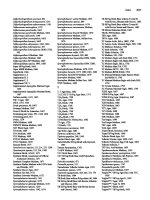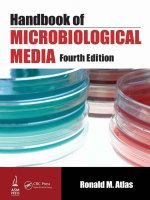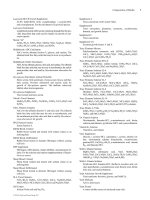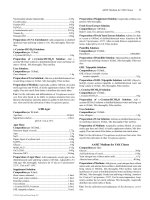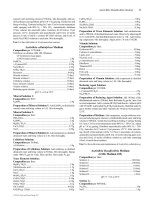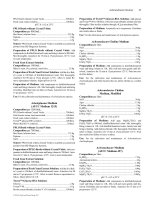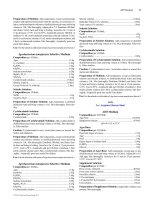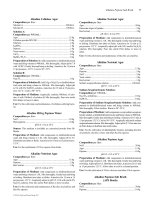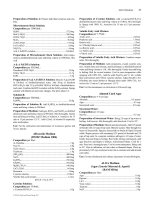Handbook of Microbiological Media, Fourth Edition part 35 pptx
Bạn đang xem bản rút gọn của tài liệu. Xem và tải ngay bản đầy đủ của tài liệu tại đây (233.26 KB, 10 trang )
Cell Growth Medium 335
Preparation of Crystal Violet Solution: Add Crystal Violet to
10.0mL of distilled/deionized water. Mix thoroughly. Autoclave for 15
min at 15 psi pressure–121°C. Cool to 25°C.
Cefsulodin Solution:
Composition
per 10.0mL:
Cefsulodin 15.0mg
Preparation of Cefsulodin Solution: Add cefsulodin to 10.0mL of
distilled/deionized water. Mix thoroughly. Filter sterilize.
Novobiocin Solution:
Composition
per 10.0mL:
Novobiocin 2.5mg
Preparation of Novobiocin Solution: Add novobiocin to 10.0mL
of distilled/deionized water. Mix thoroughly. Filter sterilize.
Strontium Chloride Solution:
Composition
per 10.0mL:
SrCl
2
·6H
2
O 1.0g
Preparation of Strontium Chloride: Add strontium chloride to
10.0mL of distilled/deionized water. Mix thoroughly. Filter sterilize.
Preparation of Medium: Add 1.0mL irgasan solution to 757.0mL
basal medium. Mix thoroughly. Cool to 50–55°C. Add 200.0mL des-
oxychlolate solution. Mix thoroughly. Solution should remain clear.
Aseptically add 1.0mL 5N NaOH, 10.0mL Neutral Red solution,
10.0mL Crystal Violet solution, 10.0mL cefsulodin solution, and
10.0mL novobiocin solution. Mix thoroughly. Slowly add 10.0mL
strontium chloride solution while continuously stirring. Adjust pH to
7.4 with 5N NaOH. Pour into sterile Petri dishes or distribute into ster-
ile tubes.
Use: For the selective isolation and differentiation of Yersinia entero-
colitica based on mannitol fermentation. Yersinia enterocolitica
appears as “bull’s eye” colonies with deep red centers surrounded by a
transparent periphery.
Cefsulodin Irgasan
®
Novobiocin Agar
See: CIN Agar
Celery Decoction Agar
Composition per liter:
Potatoes, infusion from 50.0g
Agar 15.0g
Glucose 5.0g
Celery decoction 320.0mL
pH 5.6 ± 0.2 at 25°C
Celery Decoction:
Composition
per 500.0mL:
Celery leaves and petioles 50.0g
Preparation of Celery Decoction: Coarsely cut celery into pieces.
Add celery pieces to 500.0mL of distilled/deionized water. Puree in a
blender at high speed for 2 min. Strain through a wire sieve. Gently
heat and bring to boiling. Maintain at 100°C for 5 min. Strain through
a very fine sieve or muslin.
Preparation of Medium: Add components to distilled/deionized
water and bring volume to 1.0L. Mix thoroughly. Adjust pH to 5.6 with
20% H
2
SO
4
. Gently heat and bring to boiling. Distribute into tubes or
flasks. Autoclave for 15 min at 15 psi pressure–121°C. Pour into sterile
Petri dishes or leave in tubes.
Use: For the cultivation and maintenance of Septoria apiicola.
Celery Decoction Agar
Composition per liter:
Potatoes, infusion from 200.0g
Glucose 20.0g
Agar 15.0g
Potato dextrose broth 4.0g
Celery decoction 320.0mL
pH 5.6 ± 0.2 at 25°C
Potatoes, Infusion From:
Composition per 500.0mL:
Potatoes 300.0g
Preparation of Potatoes, Infusion From: Peel and dice potatoes.
Add 500.0mL of distilled/deionized water. Gently heat and bring to
boiling. Continue boiling for 30 min. Filter through cheesecloth.
Celery Decoction:
Composition
per 500.0mL:
Celery leaves and petioles 50.0g
Preparation of Celery Decoction: Coarsely cut celery into pieces.
Add 500.0mL of distilled/deionized water. Puree in a blender at high
speed for 2 min. Strain through a kitchen-type sieve. Gently heat and
bring to boiling. Continue boiling for 5 min. Strain through a very fine
sieve or muslin.
Preparation of Medium: Add components to distilled/deionized
water and bring volume to 1.0L. Mix thoroughly. Adjust pH to 5.6 with
20% H
2
SO
4
. Gently heat and bring to boiling. Distribute into tubes or
flasks. Autoclave for 15 min at 15 psi pressure–121°C. Pour into sterile
Petri dishes or leave in tubes.
Use: For the cultivation of Septoria apiicola.
Cell Growth Medium
Composition per 2250.0mL:
Eagle’s minimal essential medium
with Hanks’ salts (MEMH) 1.0L
L 15 medium, modified Leibovitz 1.0L
Fetal calf serum 200.0mL
NaHCO
3
solution 50.0mL
pH 7.5 at 25°C
MEMH:
Composition per liter:
NaCl 8.0g
Glucose 1.0g
KCl 0.4g
CaCl
2
·2H
2
O 0.14g
MgSO
4
·7H
2
O 0.1g
KH
2
PO
4
0.06g
Na
2
HPO
4
0.05g
L-Isoleucine 0.026g
L-Leucine 0.026g
L-Lysine 0.026g
L-Threonine 0.024g
L-Valine 0.0235g
L-Tyrosine 0.018g
L-Arginine 0.0174g
L-Phenylalanine 0.0165g
L-Cystine 0.012g
L-Histidine 8.0mg
L-Methionine 7.5mg
Phenol Red 5.0mg
© 2010 by Taylor and Francis Group, LLC
336 Cellobiose Polymyxin B Colistin Agar, Modified
L-Tryptophan 4.0mg
Inositol 1.8mg
Biotin 1.0mg
Folic acid 1.0mg
Calcium pantothenate 1.0mg
Choline chloride 1.0mg
Nicotinamide 1.0mg
Pyridoxal·HCl 1.0mg
Thiamine·HCl 1.0mg
Riboflavin 0.1mg
Preparation of MEMH: Add components to distilled/deionized
water and bring volume to 1.0L. Mix thoroughly. Filter sterilize.
L 15 Medium, Modified Leibovitz:
Composition
per liter:
NaCl 8.0g
DL-Threonine 0.6g
Sodium pyruvate 0.6g
DL-Alanine 0.5g
L-Arginine, free base 0.5g
KCl 0.4g
L-Asparagine·H
2
O 0.3g
L-Histidine, free base 0.3g
L-Glutamine 0.3g
L-Isoleucine 0.3g
L-Phenylalanine 0.3g
L-Tyrosine 0.3g
DL-Methionine 0.2g
DL-Valine 0.2g
Glycine 0.2g
L-Serine 0.2g
Na
2
HPO
4
, anhydrous 0.2g
CaCl
2
, anhydrous 0.1g
L-Cysteine, free base 0.1g
L-Leucine·HCl 0.1g
Streptomycin 0.1g
MgCl
2
, anhydrous 0.094g
D-Galactose 0.09g
KH
2
PO
4
0.06g
Gentamicin 0.05g
L-Tryptophan 0.02g
Phenol Red 0.01g
i-Inositol 2.0mg
Choline chloride 1.0mg
D-Calcium pantothenate 1.0mg
Folic acid 1.0mg
Nicotinamide 1.0mg
Pyridoxine·HCl 1.0mg
Thiamine monophosphate·2H
2
O 1.0mg
Riboflavin-5-phosphate 0.1mg
Penicillin G 100,000U
pH 7.5 ± 0.2 at 25°C
Preparation of L 15 Medium, Modified Leibovitz: Add com-
ponents to distilled/deionized water and bring volume to 1.0L. Mix
thoroughly. Filter sterilize. Store at 5°C.
NaHCO
3
Solution:
Composition
per 100.0mL:
NaHCO
3
7.5g
Preparation of NaHCO
3
Solution: Add NaHCO
3
to distilled/de-
ionized water and bring volume to 100.0mL. Mix thoroughly. Filter
sterilize.
Preparation of Medium: Aseptically combine 1.0L of sterile Ea-
gle’s minimal essential medium with Hanks’ salts (MEMH) and 1.0L
of sterile L 15 medium, modified Leibovitz. Mix thoroughly. Immedi-
ately prior to use, aseptically add 200.0mL of fetal calf serum and
50.0mL of NaHCO
3
solution. Mix thoroughly. Aseptically distribute
into sterile containers.
Use: For the cultivation of mammalian HeLa or Vero tissue culture
cells to test the cytopathic effects of Escherichia coli.
Cellobiose Arginine Lysine Agar
See: CAL Agar/Broth
Cellobiose Polymyxin
B Colistin Agar, Modified
Composition per liter:
Solution 1 900.0mL
Solution 2 100.0mL
pH 7.6 ± 0.2 at 25°C
Solution 1:
Composition
per 900.0mL:
NaCl 20.0g
Agar 15.0g
Peptone 10.0g
Beef extract 5.0g
1000× dye stock solution 1.0mL
Preparation of Solution 1: Add components to distilled/deionized
water and bring volume to 900.0mL. Mix thoroughly. Adjust pH to 7.6.
Gently heat and bring to boiling. Do not autoclave. Cool to 48°–55°C.
1000X Dye Stock Solution:
Composition
per 100.0mL:
Bromthymol Blue 4.0g
Cresol Red 4.0g
Ethanol (95% solution) 100.0mL
Preparation of 1000X Dye Stock Solution: Add Bromthymol
Blue and Cresol Red to 100.0mL of ethanol. Mix thoroughly.
Solution 2:
Composition
per 100.0mL:
Cellobiose 10.0g
Colistin 400,000U
Polymyxin B 100,000U
Preparation of Solution 2: Add cellobiose to distilled/deionized
water and bring volume to 100.0mL. Mix thoroughly. Gently heat until
dissolved. Cool to 25°C. Add colistin and polymyxin B. Mix thoroughly.
Preparation of Medium: Combine cooled solution 1 and solution
2. Mix thoroughly. Do not autoclave. Pour into sterile Petri dishes.
Use: For the cultivation of Vibrio species from foods.
Cellobiose Polymyxin Colistin Agar
(CPC Agar)
Composition per liter:
Solution A 900.0mL
Solution B 100.0mL
pH 7.6 ± 0.2 at 25°C
Solution A:
Composition
per 900.0mL:
NaCl 20.0g
Agar 15.0g
© 2010 by Taylor and Francis Group, LLC
Cellulolytic Broth with Sea Salts 337
Peptone 10.0g
Beef extract 5.0g
Bromthymol Blue 0.04g
Cresol Red 0.04g
Preparation of Solution A: Add components to distilled/deionized
water and bring volume to 900.0mL. Mix thoroughly. Adjust pH to 7.6.
Gently heat and bring to boiling. Autoclave for 15 min at 15 psi pres-
sure–121°C. Cool to 50°–55°C.
Solution B:
Composition
per 100.0mL:
Cellobiose 15.0g
Colistin 1,360,000U
Polymyxin B 100,000U
Preparation of Solution B: Add components to distilled/deionized
water and bring volume to 100.0mL. Mix thoroughly. Filter sterilize.
Preparation of Medium: Aseptically combine 900.0mL of cooled,
sterile solution A and 100.0mL of sterile solution B. Mix thoroughly.
Pour into sterile Petri dishes. Use within 7 days.
Use: For the cultivation and identification of Vibrio species from
foods.
Cellulase Solution
(BAM M187)
Composition per 100.0mL:
Cellulase 1.0g
Preparation of Medium: Add cellulase to distilled/deionized water
and bring volume to 100.0mL. Mix thoroughly. Filter sterilize.
Use: For the pre-treatment of guar gum in the analysis of Salmonella
spp.The cellulase reduces the viscosity of the guar gum so that it can
be pipetted into broth or agar media.
Cellulolytic Agar with Sea Salts
Composition per liter:
Agar 20.0g
NH
4
Cl 2.0g
K
2
HPO
4
1.65g
Yeast extract 1.2g
L-Cysteine·HCl·H
2
O 0.5g
Cellulose suspension 200.0mL
Filtered seawater 200.0mL
Mineral solution 150.0mL
Resazurin (0.1% solution) 1.0mL
pH 7.2 ± 0.2 at 25°C
Cellulose Suspension:
Composition
per 200.0mL:
Cellulose powder, Whatman CF11 8.0g
Preparation of Cellulose Suspension: Add cellulose powder to
200.0mL of distilled/deionized water and mix thoroughly.
Mineral Solution:
Composition
per liter:
NaCl 6.0g
(NH
4
)
2
SO
4
6.0g
CaCl
2
0.6g
MgSO
4
0.6g
Preparation of Mineral Solution: Add components to distilled/
deionized water and bring volume to 1.0L. Mix thoroughly.
Preparation of Medium: Prepare and dispense medium anaerobi-
cally under 100% N
2
. Add components to distilled/deionized water and
bring volume to 1.0L. Mix thoroughly. Adjust pH to 7.2 with 5M
NaOH. Distribute into tubes or flasks. Autoclave for 15 min at 15 psi
pressure–121°C.
Use: For the cultivation and maintenance of Clostridium papyrosol-
vens and other marine bacteria that can utilize cellulose as a carbon
source.
Cellulolytic Agar for Thermophiles
Composition per liter:
Agar 30.0g
K
2
HPO
4
1.65g
NH
4
SO
4
1.6g
Yeast extract 1.0g
NaCl 0.96g
L-Cysteine·HCl·H
2
O 0.5g
CaCl
2
0.096g
MgSO
4
0.096g
Cellulose suspension 200.0mL
Resazurin (0.1% solution) 1.0mL
pH 7.2 ± 0.2 at 25°C
Cellulose Suspension:
Composition
per 200.0mL:
Cellulose powder, Whatman CF11 8.0g
Preparation of Cellulose Suspension: Add cellulose powder to
200.0mL of distilled/deionized water and mix thoroughly.
Preparation of Medium: Prepare and dispense medium anaerobi-
cally in 100% N
2
. Add components to distilled/deionized water and
bring volume to 1.0L. Mix thoroughly. Adjust pH to 7.2 with 5M
NaOH. Distribute into tubes or flasks. Autoclave for 15 min at 15 psi
pressure–121°C.
Use: For cultivation of Clostridium stercorarium and other bacteria
that can utilize cellulose as a carbon source.
Cellulolytic Broth for Thermophiles
Composition per liter:
K
2
HPO
4
1.65g
NH
4
SO
4
1.6g
Yeast extract 1.0g
NaCl 0.96g
L-Cysteine·HCl·H
2
O 0.5g
CaCl
2
0.096g
MgSO
4
0.096g
Resazurin (0.1% solution) 1.0mL
pH 7.2 ± 0.2 at 25°C
Preparation of Medium: Prepare and dispense medium anaerobi-
cally in 100% N
2
. Add components to distilled/deionized water and
bring volume to 1.0L. Mix thoroughly. Adjust pH to 7.2 with 5M
NaOH. Distribute into tubes or flasks that contain cellulose as a strip
(4.5cm × 1.0cm) of Whatman #1 filter paper. Autoclave for 15 min at
15 psi pressure–121°C.
Use: For the cultivation of Clostridium stercorarium and other bacte-
ria that can utilize cellulose as a carbon source.
Cellulolytic Broth with Sea Salts
Composition per liter:
K
2
HPO
4
1.65g
NH
4
Cl 1.0g
© 2010 by Taylor and Francis Group, LLC
338 Cellulolytic Clostridia Medium
Yeast extract 0.6g
L-Cysteine·HCl·H
2
O 0.5g
Filtered seawater 200.0mL
Mineral solution 150.0mL
Resazurin (0.1% solution) 1.0mL
pH 7.2 ± 0.2 at 25°C
Mineral Solution:
Composition
per liter:
NaCl 6.0g
(NH
4
)
2
SO
4
6.0g
CaCl
2
0.6g
MgSO
4
0.6g
Preparation of Mineral Solution: Add components to distilled/
deionized water and bring volume to 1.0L. Mix thoroughly.
Preparation of Medium: Prepare and dispense medium anaerobi-
cally in 100% N
2
atmosphere. Add components to distilled/deionized
water and bring volume to 1.0L. Adjust pH to 7.2 with 5M NaOH. Dis-
tribute into tubes or flasks that contain cellulose as a strip (4.5cm ×
1.0cm) of Whatman No. 1 filter paper. Autoclave for 15 min at 15 psi
pressure–121°C.
Use: For the cultivation and maintenance of Clostridium papyrosol-
vens and other marine bacteria that can utilize cellulose as a carbon
source.
Cellulolytic Clostridia Medium
Composition per liter:
Cellulose 20.0g
CaCO
3
2.0g
K
2
HPO
4
1.0g
(NH
4
)
2
SO
4
1.0g
MgSO
4
·7H
2
O 0.5g
NaCl 0.5g
Resazurin 1.0mg
pH 7.1 ± 0.2 at 25°C
Preparation of Medium: Add components to distilled/deionized
water and bring volume to 1.0L. Mix thoroughly. Distribute into tubes
or flasks. Autoclave for 15 min at 15 psi pressure–121°C.
Use: For the isolation, cultivation, and enrichment of cellulolytic
Clostridium species.
Cellulolytic Medium
Composition per liter:
NaHCO
3
2.06g
Cellulose 2.0g
NH
4
Cl 0.68g
K
2
HPO
4
0.296g
KH
2
PO
4
0.18g
(NH
4
)
2
SO
4
0.15g
MgSO
4
·7H
2
O 0.12g
CaCl
2
·2H
2
O 61.0mg
FeSO
4
·7H
2
O 21.0mg
Nitrilotriacetic acid 15.0mg
NaCl 10.0mg
MnSO4·H
2
O 5.0mg
CoCl
2
·H
2
O 1.0mg
Resazurin 1.0mg
ZnSO
4
·7H
2
O 1.0mg
CuSO
4
·5H
2
O 0.1mg
H
3
BO
3
0.1mg
KAl(SO
4
)
2
·12H
2
O 0.1mg
Na
2
MoO
4
·2H
2
O 0.1mg
Wolfe’s vitamin solution 10.0mL
L-Cysteine·HCl·H
2
O solution 5.0mL
pH 7.5 ± 0.2 at 25°C
Wolfe’s Vitamin Solution:
Composition per liter:
Pyridoxine·HCl 10.0mg
Thiamine·HCl 5.0mg
Riboflavin 5.0mg
Nicotinic acid 5.0mg
Calcium
DL-pantothenate 5.0mg
p-Aminobenzoic acid 5.0mg
Thioctic acid 5.0mg
Biotin 2.0mg
Folic acid 2.0mg
Cyanocobalamin 100.0μg
Preparation of Wolfe’s Vitamin Solution: Add components to
distilled/deionized water and bring volume to 1.0L. Mix thoroughly. Filter
sterilize.
L-Cysteine·HCl·H
2
O Solution:
Composition
per 20.0mL:
L-Cysteine·HCl·H
2
O 1.0g
Preparation of L-Cysteine·HCl·H
2
O Solution: Add L-
cysteine·HCl·H
2
O to distilled/deionized water and bring volume to
20.0mL. Mix thoroughly. Filter sterilize.
Preparation of Medium: Add components, except Wolfe’s vitamin
solution and L-cysteine·HCl·H
2
O solution, to distilled/deionized water and
bring volume to 985.0mL. Mix thoroughly. Autoclave for 15 min at 15 psi
pressure–121°C. Aseptically add 10.0mL of sterile Wolfe’s vitamin solu-
tion and 5.0mL of sterile
L-cysteine·HCl·H
2
O solution. Mix thoroughly.
Aseptically distribute into sterile tubes or flasks.
Use: For the cultivation of cellulolytic bacteria.
Cellulolytic Medium with Rumen Fluid
Composition per liter:
Basal medium 975.0mL
Alkaline solution 25.0mL
pH 6.8 ± 0.2 at 25°C
Basal Medium:
Composition
per 975.0mL:
Agar 15.0g
NaHCO
3
6.37g
Pancreatic digest of casein 5.0g
Cellobiose 5.0g
NaCl 0.9g
(NH
4
)
2
SO
4
0.9g
K
2
HPO
4
0.45g
KH
2
PO
4
0.45g
MgSO
4
·7H
2
O 0.18g
CaCl
2
0.09g
Resazurin 1.0mg
Rumen fluid, clarified 400.0mL
Preparation of Basal Medium: Add components to distilled/de-
ionized water and bring volume to 975.0mL. Mix thoroughly. Gently
heat and bring to boiling under a gas phase of 98% CO
2
+ 2% H
2
. Cool
slightly.
© 2010 by Taylor and Francis Group, LLC
Cellulose Agar 339
Alkaline Solution:
Composition per 25.0mL:
L-Cysteine·HCl·H
2
O 0.25g
Na
2
S·9H
2
O 0.25g
Preparation of Alkaline Solution: Add components to 25.0mL of
distilled/deionized water. Mix thoroughly. Prepare freshly.
Preparation of Medium: Prepare 975.0mL of basal medium. Heat
to boiling and cool to 25°C. Add 25.0mL of freshly prepared alkaline
solution. Distribute into tubes using anaerobic techniques under a gas
phase of 98% CO
2
+ 2% H
2
. Autoclave for 15 min at 15 psi pressure–
121°C. Adjust pH to 6.8.
Use: For the cultivation and maintenance of Clostridium polysaccha-
rolyticum.
Cellulolytic Medium with
Rumen Fluid and Soluble Starch
Composition per liter:
Basal medium 975.0mL
Alkaline solution 25.0mL
pH 6.8 ± 0.2 at 25°C
Basal Medium:
Composition
per 975.0mL:
Agar 15.0g
NaHCO
3
6.37g
Pancreatic digest of casein 5.0g
Cellobiose 5.0g
Soluble starch 5.0g
NaCl 0.9g
(NH
4
)
2
SO
4
0.9g
K
2
HPO
4
0.45g
KH
2
PO
4
0.45g
MgSO
4
·7H
2
O 0.18g
CaCl
2
0.09g
Resazurin 1.0mg
Preparation of Basal Medium: Add components to distilled/de-
ionized water and bring volume to 975.0mL. Mix thoroughly. Gently
heat and bring to boiling under a gas phase of 98% CO
2
+ 2% H
2
. Cool
slightly.
Alkaline Solution:
Composition per 25.0mL:
L-Cysteine·HCl·H
2
O 0.25g
Na
2
S·9H
2
O 0.25g
Preparation of Alkaline Solution: Add components to 25.0mL of
distilled/deionized water. Mix thoroughly. Prepare freshly.
Preparation of Medium: Prepare 975.0mL of basal medium. Heat
to boiling and cool to 25°C. Add 25.0mL of freshly prepared alkaline
solution. Distribute into tubes using anaerobic techniques under a gas
phase of 98% CO
2
+ 2% H
2
. Autoclave for 15 min at 15 psi pressure–
121°C. Adjust pH to 6.8.
Use: For the cultivation of Selenomonas ruminantium and Succinimo-
nas amylolytica.
Cellulomonas fermentans Medium
Composition per liter:
Yeast extract 5.0g
K
2
HPO
4
.2.21g
KH
2
PO
4
1.5g
(NH
4
)
2
SO
4
1.3g
MgCl
2
·6H
2
O 0.1g
CaCl
2
·2H
2
O 0.02g
FeSO
4
·7H
2
O 1.25mg
Resazurin 1.0mg
Cellobiose solution 50.0mL
NaHCO
3
solution 10.0mL
L-Cysteine·HCl solution 10.0mL
pH 7.4 ± 0.2 at 25°C
Cellobiose Solution:
Composition per 50.0mL:
D-Cellobiose (or cellulose) 5.0g
Preparation of Cellobiose Solution: Add cellobiose (or cellu-
lose) to distilled/deionized water and bring volume to 50.0mL. Mix
thoroughly. Autoclave under 100% N
2
for 15 min at 15 psi pressure–
121°C.
NaHCO
3
Solution:
Composition
per 10.0mL:
NaHCO
3
0.8g
Preparation of NaHCO
3
Solution: Add NaHCO
3
to distilled/de-
ionized water and bring volume to 10.0mL. Mix thoroughly. Autoclave
under 100% N
2
for 15 min at 15 psi pressure–121°C.
L-Cysteine·HCl Solution:
Composition
per 10.0mL:
L-Cysteine·HCl 0.5g
Preparation of L-Cysteine·HCl Solution: Add L-cysteine·HCl to
distilled/deionized water and bring volume to 10.0mL. Mix thorough-
ly. Autoclave under 100% N
2
for 15 min at 15 psi pressure–121°C.
Preparation of Medium: Add components, except cellobiose solu-
tion, NaHCO
3
solution, and L-cysteine·HCl solution, to distilled/deion-
ized water and bring volume to 930.0mL. Mix thoroughly. Sparge
under 100% N
2
for 10 min. Autoclave under 100% N
2
for 15 min at 15
psi pressure–121°C. Aseptically and anaerobically add 50.0mL of ster-
ile cellobiose solution, 10.0mL of sterile NaHCO
3
solution, and
10.0mL of sterile
L-cysteine·HCl solution. Mix thoroughly.
Use: For the cultivation and maintenance of Cellulomonas fermen-
tans
.
Cellulomonas PTYG Medium
(Cellulomonas Peptone Tryptone
Yeast Extract Glucose Medium)
Composition per liter:
Agar 15.0g
Glucose 5.0g
Peptone 5.0g
Pancreatic digest of casein 5.0g
Yeast extract 5.0g
Preparation of Medium: Add components to distilled/deionized
water and bring volume to 1.0L. Mix thoroughly. Gently heat and bring
to boiling. Distribute into tubes or flasks. Autoclave for 15 min at 15
psi pressure–121°C. Pour into sterile Petri dishes or leave in tubes.
Use: For the cultivation and maintenance of Cellulomonas species.
Cellulose Agar
Composition per liter:
Agar 20.0g
Cellulose, ball milled 10.0g
KH
2
PO
4
1.0g
© 2010 by Taylor and Francis Group, LLC
340 Cellulose Anaerobe Medium
(NH
4
)
2
SO
4
0.5g
L-Asparagine 0.5g
KCl 0.5g
Yeast extract 0.5g
MgSO
4
0.2g
CaCl
2
0.1g
pH 6.2 ± 0.2 at 25°C
Preparation of Medium: Add components to distilled/deionized
water and bring volume to 1.0L. Gently heat and bring to boiling. Ad-
just pH to 6.2. Distribute into tubes or flasks. Autoclave for 15 min at
15 psi pressure–121°C. Pour into sterile Petri dishes or leave in tubes.
Use: For the cultivation and maintenance of Achaetomium globosum,
Chaetomium anahelicinum, Chaetomium apiculatum, Chaetomium
atrobrunneum, Chaetomium carinthiacum, Chaetomium globosum,
Chaetomium medusarum, Chaetomium quadrangulatum, Chaetomium
reflexum, Chaetomium thielavioideum, Chaetomium undulatum,
Chaetomium variosporum, and Chrysosporium pannorum.
Cellulose Anaerobe Medium
(LMG Medium 94)
Composition per liter:
NaHCO
3
2.1g
Cellulose 2.0g
NH
4
Cl 0.68g
KH
2
PO
4
0.18g
(NH
4
)
2
SO
4
0.15g
MgSO
4
·7H
2
O 0.12g
K
2
HPO
4
296.0mg
CaCl
2
·2H
2
O 61.0mg
FeSO
4
·7H
2
O 21.0mg
Nitrilotriacetic acid 15.0mg
NaCl 10.0mg
MnSO
4
·H
2
O 5.0mg
CoCl
2
·6H
2
O 1.0mg
ZnSO
4
·7H
2
O 1.0mg
Resazurin 1.0mg
CuSO
4
·5H
2
O 0.1mg
KAl(SO
4
)
2
·12H
2
O 0.1mg
H
3
BO
3
0.1mg
Na
2
MoO
4
·2H
2
O 0.1mg
Vitamin solution 5.0mL
Cysteine hydrochloride solution 5.0mL
pH 7.1 ± 0.2 at 25°C
Vitamin Solution:
Composition
per liter:
Pyridoxine·HCl 10.0mg
Calcium
DL-pantothenate 5.0mg
Lipoic acid 5.0mg
Nicotinic acid 5.0mg
p-Aminobenzoic acid 5.0mg
Riboflavin 5.0mg
Thiamine·HCl 5.0mg
Biotin 2.0mg
Folic acid 2.0mg
Vitamin B
12
0.1mg
Preparation of Vitamin Solution: Add components to distilled/
deionized water and bring volume to 1.0L. Mix thoroughly. Filter ster-
ilize.
L-Cysteine Solution:
Composition
per 10.0mL:
L-Cysteine·HCl·H
2
O 0.5g
Preparation of L-Cysteine Solution: Add L-cysteine·HCl·H
2
O to
distilled/deionized water and bring volume to 10.0mL. Mix thorough-
ly. Sparge with 100% N
2
. Autoclave for 15 min at 15 psi pressure–
121°C.
Preparation of Medium: Add nitrilotriacetic acid to 500.0mL of
distilled/deionized water. Adjust pH to 6.5 with KOH. Add remaining
components except vitamin solution and cysteine hydrochloride solu-
tion. Add 485.0mL distilled/deionized water. Adjust pH to 7.1. Auto-
clave for 15 min at 15 psi pressure–121°C. Cool to 50°C. Aseptically
add 10.0mL of sterile vitamin solution and 5.0mL sterile cysteine hy-
drochloride solution. Mix thoroughly. Aseptically distribute to tubes or
flasks.
Use: For the cultivation of cellulose-utilizing anerobic bacteria.
Cellulose Broth
Composition per liter:
Cellulose, powdered 1.0g
K
2
HPO
4
1.0g
(NH
4
)
2
SO
4
1.0g
MgSO
4
·7H
2
O 0.2g
CaCl
2
·2H
2
O 0.1g
FeCl
3
0.02g
pH 7.0–7.5 at 25°C
Preparation of Medium: Add cellulose to 100.0mL of distilled/de-
ionized water. Mix thoroughly. In a separate flask, add remaining com-
ponents to distilled/deionized water and bring volume to 900.0mL.
Mix thoroughly. Autoclave both solutions separately for 15 min at 15
psi pressure–121°C. Cool to 45°–50°C. Aseptically combine the two
sterile solutions. Mix thoroughly. Aseptically distribute into sterile
tubes or flasks.
Use: For the isolation and cultivation of Cytophaga species, Herpeto-
siphon species, Saprospira species, and Flexithrix species.
Cellulose Overlay Agar
Composition per plate:
Stan 5 agar 15.0mL
Cellulose overlay agar 5.0mL
Stan 5 Agar:
Composition per liter:
Solution B 650.0mL
Solution A 350.0mL
Solution A:
Composition per 350.0mL:
CaCl
2
·2H
2
O 1.0g
(NH
4
)
2
SO
4
1.0g
MgSO
4
·7H
2
O 1.0g
Trace elements solution 1.0mL
Preparation of Solution A: Add components to distilled/deionized
water and bring volume to 350.0mL. Mix thoroughly. Gently heat and
bring to boiling. Autoclave for 15 min at 15 psi pressure–121°C. Cool
to 45°–50°C.
Trace Elements Solution:
Composition per liter:
EDTA 8.0g
MnCl
2
·4H
2
O 0.1g
© 2010 by Taylor and Francis Group, LLC
CENS Medium 341
CoCl
2
0.02g
KBr 0.02g
ZnCl
2
0.02g
CuSO
4
0.01g
H
3
BO
3
0.01g
NaMoO
4
·2H
2
O 0.01g
BaCl
2
5.0mg
LiCl 5.0mg
SnCl
2
·2H
2
O 5.0mg
Preparation of Trace Elements Solution: Add components to
distilled/deionized water and bring volume to 1.0L. Mix thoroughly.
Solution B:
Composition per 650.0mL:
Agar 10.0g
K
2
HPO
4
1.0g
Preparation of Solution B: Add components to distilled/deionized
water and bring volume to 650.0mL. Mix thoroughly. Gently heat and
bring to boiling. Autoclave for 15 min at 15 psi pressure–121°C. Cool
to 45°–50°C.
Preparation of Stan 5 Agar: Aseptically combine 350.0mL of
cooled, sterile solution A and 650.0mL of cooled, sterile solution B.
Mix thoroughly.
Cellulose Overlay Agar:
Composition per liter:
Solution A 350.0mL
Solution B 650.0mL
Solution A:
Composition per 350.0mL:
CaCl
2
·2H
2
O 1.0g
(NH
4
)
2
SO
4
1.0g
MgSO
4
·7H
2
O 1.0g
Trace elements solution 1.0mL
Preparation of Solution A: Add components to distilled/deionized
water and bring volume to 350.0mL. Mix thoroughly. Gently heat and
bring to boiling. Autoclave for 15 min at 15 psi pressure–121°C. Cool
to 45°–50°C.
Trace Elements Solution:
Composition per liter:
EDTA 8.0g
MnCl
2
·4H
2
O 0.1g
CoCl
2
0.02g
KBr 0.02g
ZnCl
2
0.02g
CuSO
4
0.01g
H
3
BO
3
0.01g
NaMoO
4
·2H
2
O 0.01g
BaCl
2
5.0mg
LiCl 5.0mg
SnCl
2
·2H
2
O 5.0mg
Preparation of Trace Elements Solution: Add components to
distilled/deionized water and bring volume to 1.0L. Mix thoroughly.
Solution B:
Composition per 650.0mL:
Agar 10.0g
K
2
HPO
4
1.0g
Preparation of Solution B: Add components to distilled/deionized
water and bring volume to 650.0mL. Mix thoroughly. Gently heat and
bring to boiling. Autoclave for 15 min at 15 psi pressure–121°C. Cool
to 45°–50°C.
Preparation of Cellulose Overlay Agar: Aseptically combine
350.0mL of cooled, sterile solution A and 650.0mL of cooled, sterile
solution B. Mix thoroughly.
Preparation of Medium: Pour cooled, sterile Stan 5 agar into ster-
ile Petri dishes in 15.0mL volumes. Allow agar to solidify. Overlay
each plate with 5.0mL of cellulose overlay agar.
Use: For the cultivation of myxobacteria.
Cellvibrio Medium
Composition per liter:
Agar 15.0g
NaNO
3
5.0g
K
2
HPO
4
1.0g
MgSO
4
·7H
2
O 0.5g
KCl 0.5g
FeSO
4
·7H
2
O 10.0mg
pH 7.2 ± 0.2 at 25°C
Preparation of Medium: Add components to distilled/deionized
water and bring volume to 1.0L. Mix thoroughly. Gently heat and bring
to boiling. Distribute into tubes or flasks. Autoclave for 15 min at 15
psi pressure–121°C. Pour into sterile Petri dishes or leave in tubes.
Use: For the cultivation and maintenance of Cellvibrio mixtus,
Cytophaga aurantiaca, Cytophaga hutchinsonii, and Sporocytophaga
myxococcoides.
CENS Medium
(DSMZ Medium 748)
Composition per liter:
Soytone 4.0g
NH
4
Cl 1.0g
K
2
HPO
4
0.9g
KH
2
PO
4
0.6g
Na
2
S
2
O
3
·5H
2
O 0.5g
MgSO
4
·7H
2
O 0.2g
CaCl
2
·2H
2
O 75.0mg
EDTA 5.0mg
Vitamin B
12
20.0µg
Biotin 15.0µg
Na-pyruvate solution 10.0mL
Chelated iron solution 2.0mL
True Blue trace elements 1.0mL
pH 7.0 ± 0.2 at 25°C
Na-pyruvate Solution:
Composition
per 10.0mL:
Na-pyruvate 2.2g
Preparation of Na-pyruvate Solution: Add Na-pyruvate to dis-
tilled/deionized water and bring volume to 10.0mL. Mix thoroughly.
Sparge with 100% N
2
. Filter sterilize.
True Blue Trace Elements:
Composition
per 250mL:
EDTA 2.5g
MnCl
2
·4H
2
O 0.2g
H
3
BO
3
0.1g
Na
2
MoO
4
·4H
2
O 0.1g
ZnCl
2
50.0mg
NiCl
2
·6H
2
O 50.0mg
© 2010 by Taylor and Francis Group, LLC
342 CENS Medium
CoCl
2
·2H
2
O 20.0mg
CuCl
2
·2H
2
O 10.0mg
Na
2
SeO
3
5.0mg
NaVO
3
·H
2
O 5.0mg
Preparation of True Blue Trace Elements: Add components
one at a time to approximately 200.0mL distilled/deionized water.
Bring final volume to 250.0mL with additional distilled/deionized wa-
ter.
Chelated Iron Solution:
Composition
per 900mL:
EDTA 2.0g
FeCl
2
·4H
2
O 1.0g
HCl 3.0mL
Preparation of Chelated Iron Solution: Add components to dis-
tilled/deionized water and bring volume to 900.0mL. Mix thoroughly.
Preparation of Medium: Add components, except Na-pyruvate so-
lution, to distilled/deionized water and bring volume to 990.0L. Mix
thoroughly. Autoclave for 15 min at 15 psi pressure–121°C. Cool to
25°C. Aseptically add 10.0mL sterile Na-pyruvate solution. Aseptical-
ly distribute into sterile tubes or flasks.
Use: For the cultivation of Rhodocista centenaria (Rhodospirillum cen-
tenum).
CENS Medium
Composition per liter:
Papaic digest of soybean meal 4.0g
NH
4
Cl 1.0g
K
2
HPO
4
0.9g
KH
2
PO
4
0.6g
Na
2
S
2
O
3
·5H
2
O 0.5g
MgSO
4
·7H
2
O 0.2g
CaCl
2
·2H
2
O 75.0mg
EDTA 5.0mg
Vitamin B
12
20.0μg
D-Biotin 15.0μg
Sodium pyruvate solution 10.0mL
Chelated iron solution 2.0mL
True Blue trace elements 1.0mL
pH 6.8 ± 0.2 at 25°C
Sodium Pyruvate Solution:
Composition
per 10.0mL:
Sodium pyruvate 2.2g
Preparation of Sodium Pyruvate Solution: Add sodium pyru-
vate to distilled/deionized water and bring volume to 10.0mL. Mix
thoroughly. Filter sterilize.
Chelated Iron Solution:
Composition
per 900.0mL:
EDTA 2.0g
FeCl
2
·4H
2
O 1.0g
HCl, concentrated 3.0mL
Preparation of Chelated Iron Solution: Add components to dis-
tilled/deionized water and bring volume to 900.0mL. Mix thoroughly.
True Blue Trace Elements:
Composition
per 250.0mL:
EDTA 2.5g
MnCl
2
. 4H
2
O 0.2g
H
3
BO
3
0.1g
Na
2
MoO
4
·2H
2
O 0.1g
ZnCl2 50.0mg
NiCl
2
·6H
2
O 50.0mg
CoCl
2
·6H
2
O 20.0mg
CuCl
2
·2H
2
O 10.0mg
Na
2
SeO
3
5.0mg
NaVO
3
5.0mg
Preparation of True Blue Trace Elements: Add components,
one at a time, to 200.0mL of distilled/deionized water. Mix thoroughly.
Bring volume to 250.0mL with distilled/deionized water.
Preparation of Medium: Add components to distilled/deionized
water and bring volume to 1.0L. Mix thoroughly. Adjust pH to 6.8.
Distribute into tubes or flasks. Autoclave for 15 min at 15 psi pressure–
121°C.
Use: For the cultivation of Rhodospirillum centenum.
Centenum Medium
Composition per liter of tap water:
Agar 20.0g
Yeast extract 10.0g
Sodium pyruvate 2.2g
K
2
HPO
4
1.0g
MgSO
4
0.5g
Vitamin B
12
0.02mg
pH 7.0–7.2 at 25°C
Preparation of Medium: Add components to distilled/deionized
water and bring volume to 1.0L. Mix thoroughly. Gently heat and bring
to boiling. Distribute into tubes or flasks. Autoclave for 15 min at 15
psi pressure–121°C. Pour into sterile Petri dishes or leave in tubes.
Use: For the cultivation and maintenance of Rhodospirillum species.
Cephalothin Cycloheximide Vancomycin Colistin Medium
See: CCVC Medium
Ceratocystis Medium
Composition per liter:
Glucose 5.0g
Ammonium tartrate 5.0g
Asparagine 1.0g
KH
2
PO
4
1.0g
MgSO
4
·7H
2
O 0.5g
CaCl
2
0.1g
NaCl 0.1g
Inositol 10.0mg
ZnSO
4
·7H
2
O 4.43mg
MNSO
4
·4H
2
O 4.05mg
FeCl
3
·6H
2
O 4.0mg
Pyridoxine 0.1mg
Thiamine 0.1mg
Preparation of Medium: Add components to distilled/deionized
water and bring volume to 1.0L. Mix thoroughly. Gently heat and bring
to boiling. Distribute into tubes or flasks. Autoclave for 15 min at 15
psi pressure–121°C.
Use: For the cultivation of Ceratocystis multiannulata.
Cereal Agar
Composition per liter:
Cereal, precooked mixed 100.0g
Agar 15.0g
© 2010 by Taylor and Francis Group, LLC
Cetrimide HiVeg Agar Base with Glycerol and Nalidixic Selective Supplement 343
Preparation of Medium: Add components to distilled/deionized
water and bring volume to 1.0L. Mix thoroughly. Gently heat and bring
to boiling. Autoclave for 15 min at 15 psi pressure–121°C. Pour into
sterile Petri dishes or distribute into sterile tubes. Allow tubes to cool
in a slanted position.
Use: For the cultivation and sporulation of fungi.
Cetrimide Agar, Non-USP
Composition per liter:
Beef heart, solids from infusion 500.0g
Agar 15.0g
Tryptose 10.0g
NaCl 5.0g
Cetrimide 0.9g
pH 7.2 ± 0.2 at 25°C
Preparation of Medium: Add components to distilled/deionized
water and bring volume to 1.0L. Mix thoroughly. Gently heat and bring
to boiling. Distribute into tubes or flasks. Autoclave for 15 min at 13
psi pressure–118°C. Pour into sterile Petri dishes or leave in tubes.
Use: For the selective isolation, cultivation, and identification of
Pseudomonas aeruginosa and other Gram-negative, nonfermentative
bacteria.
Cetrimide Agar, USP
(Pseudosel
®
Agar)
Composition per liter:
Pancreatic digest of gelatin 20.0g
Agar 13.6g
K
2
SO
4
10.0g
MgCl
2
1.4g
Cetrimide 0.3g
Glycerol 10.0mL
pH 7.2 ± 0.2 at 25°C
Source: This medium is available as a premixed powder from BD Di-
agnostic Systems.
Preparation of Medium: Add components to distilled/deionized
water and bring volume to 1.0L. Mix thoroughly. Gently heat and bring
to boiling. Distribute into tubes or flasks. Autoclave for 15 min at 13
psi pressure–118°C. Pour into sterile Petri dishes or leave in tubes.
Use: For the selective isolation, cultivation, and identification of
Pseudomonas aeruginosa and other Gram-negative, nonfermentative
bacteria.
Cetrimide Agar Base with Glycerol
Composition per liter:
Pancreatic digest of gelatin 20.0g
K
2
SO
4
10.0g
MgCl
2
1.4g
Cetrimide 0.3g
Glycerol 10.0mL
pH 7.2 ± 0.2 at 25°C
Source: This medium, without glycerol, is available as a premixed
powder from HiMedia.
Preparation of Medium: Add components to distilled/deionized
water and bring volume to 1.0L. Mix thoroughly. Gently heat and bring
to boiling. Distribute into tubes or flasks. Autoclave for 15 min at 13
psi pressure–118°C. Pour into sterile Petri dishes or leave in tubes.
Use: For the selective isolation, cultivation, and identification of
Pseudomonas aeruginosa and other Gram-negative, nonfermentative
bacteria.
Cetrimide Agar Base
with Glycerol and Nalidixic Selective Supplement
Composition per liter:
Pancreatic digest of gelatin 20.0g
K
2
SO
4
10.0g
MgCl
2
1.4g
Cetrimide 0.3g
Glycerol 10.0mL
Nalidixic selective supplement 5.0mL
pH 7.2 ± 0.2 at 25°C
Source: This medium, without glycerol and nalidixic acid supple-
ment, is available as a premixed powder from HiMedia.
Nalidixic Selective Supplement:
Composition
per 5.0mL:
Nalidixic acid 15.0mg
Preparation of Nalidixic Selective Supplement: Add nalidixic
acid to distilled/deionized water and bring volume to 50.0mL. Mix
thoroughly. Filter sterilize.
Preparation of Medium: Add components, except nalidixic selec-
tive supplement, to distilled/deionized water and bring volume to 1.0L.
Mix thoroughly. Gently heat and bring to boiling. Distribute into tubes
or flasks. Autoclave for 15 min at 15 psi pressure–121°C. Cool to
50°C. Aseptically add 5.0mL sterile nalidixic selective supplement.
Mix thoroughly. Pour into sterile Petri dishes or leave in tubes.
Use: For the selective isolation, cultivation, and identification of
Pseudomonas aeruginosa and other Gram-negative, nonfermentative
bacteria.
Cetrimide HiVeg Agar Base with Glycerol
Composition per liter:
Plant peptone No. 2 20.0g
K
2
SO
4
10.0g
MgCl
2
1.4g
Cetrimide 0.3g
Glycerol 10.0mL
pH 7.2 ± 0.2 at 25°C
Source: This medium, without glycerol, is available as a premixed
powder from HiMedia.
Preparation of Medium: Add components to distilled/deionized
water and bring volume to 1.0L. Mix thoroughly. Gently heat and bring
to boiling. Distribute into tubes or flasks. Autoclave for 15 min at 13
psi pressure–118°C. Pour into sterile Petri dishes or leave in tubes.
Use: For the selective isolation, cultivation, and identification of
Pseudomonas aeruginosa and other Gram-negative, nonfermentative
bacteria.
Cetrimide HiVeg Agar Base
with Glycerol and Nalidixic Selective Supplement
Composition per liter:
Plant peptone No. 2 20.0g
K
2
SO
4
10.0g
MgCl
2
1.4g
Cetrimide 0.3g
© 2010 by Taylor and Francis Group, LLC
344 CF Assay Medium
Glycerol 10.0mL
Nalidixic selective supplement 5.0mL
pH 7.2 ± 0.2 at 25°C
Source: This medium, without glycerol and nalidixic acid supple-
ment, is available as a premixed powder from HiMedia.
Nalidixic Selective Supplement:
Composition
per 5.0mL:
Nalidixic acid 15.0mg
Preparation of Nalidixic Selective Supplement: Add nalidixic
to distilled/deionized water and bring volume to 50.0mL. Mix thor-
oughly. Filter sterilize.
Preparation of Medium: Add components, except nalidixic selec-
tive supplement, to distilled/deionized water and bring volume to 1.0L.
Mix thoroughly. Gently heat and bring to boiling. Distribute into tubes
or flasks. Autoclave for 15 min at 15 psi pressure–121°C. Cool to
50°C. Aseptically add 5.0mL sterile nalidixic selective supplement.
Mix thoroughly. Pour into sterile Petri dishes or leave in tubes.
Use: For the selective isolation, cultivation, and identification of
Pseudomonas aeruginosa and other Gram-negative, nonfermentative
bacteria.
CF Assay Medium
(Citrovorum Factor Assay Medium)
Composition per liter:
Glucose 50.0g
Sodium acetate 40.0g
Vitamin assay casamino acids 10.0g
NH
4
Cl 6.0g
K
2
HPO
4
1.2g
KH
2
PO
4
1.2g
MgSO
4
·7H
2
O 0.4g
DL-Alanine 0.2g
DL-Tryptophan 0.2g
L-Cystine 0.2g
L-Cysteine·HCl 0.2g
MgSO
4
·7H
2
O 0.04g
Adenine sulfate 0.02g
FeSO
4
0.02g
Glycine 0.02g
Guanine·HCl 0.02g
NaCl 0.02g
Uracil 0.02g
Xanthine 0.02g
Pyridoxamine·HCl 6.0mg
Nicotinic acid 2.0mg
Pyridoxine·HCl 2.0mg
Calcium pantothenate 1.0mg
Riboflavin 1.0mg
Thiamine·HCl 1.0mg
Pyridoxal·HCl 600.0μg
p-Aminobenzoic acid 200.0μg
Folic acid 20.0μg
Biotin 2.0μg
pH 6.7 ± 0.2 at 25°C
Preparation of Medium: Add components to distilled/deionized
water and bring volume to 1.0L. Mix thoroughly. Gently heat and bring
to boiling. Continue boiling for 2–3 min. Allow precipitate to settle out.
Distribute supernatant into tubes in 5.0mL volumes. Add standard so-
lution or test solutions to each tube. Adjust the volume of each tube to
10.0mL with distilled/deionized water. Autoclave for 10 min at 15 psi
pressure–121°C.
Use: For the microbiological assay of citrovorum factor using Pedio-
coccus acidilactici.
CFAT Medium
(Cadmium Fluoride Acriflavin Tellurite Medium)
Composition per liter:
Pancreatic digest of casein 17.0g
Agar 15.0g
Glucose 7.5g
NaCl 5.0g
Papaic digest of soybean meal 3.0g
K
2
HPO
4
2.5g
NaF 0.8g
CdSO
4
0.013g
K
2
TeO
3
2.5mg
Neutral acriflavin 1.2mg
Basic Fuchsin 0.25mg
Sheep blood, defibrinated 50.0mL
Caution: Potassium tellurite is toxic.
Preparation of Medium: Add components, except sheep blood, to
distilled/deionized water and bring volume to 950.0mL. Mix thorough-
ly. Gently heat and bring to boiling. Autoclave for 15 min at 15 psi
pressure–121°C. Cool to 45°–50°C. Add 50.0mL of sterile, defibrinat-
ed sheep blood. Mix thoroughly. Pour into sterile Petri dishes or leave
in tubes.
Use: For the isolation, cultivation, and enumeration of Actinomyces
viscosus and Actinomyces naeslundii from clinical specimens, espe-
cially dental plaque.
CGY Agar
Composition per liter:
Agar 20.0g
Pancreatic digest of casein 5.0g
Yeast extract 1.0g
Glycerol 10.0mL
pH 7.2 ± 0.2 at 25°C
Preparation of Medium: Add components to distilled/deionized
water and bring volume to 1.0L. Mix thoroughly. Gently heat and bring
to boiling. Distribute into tubes or flasks. Autoclave for 15 min at 15
psi pressure–121°C. Pour into sterile Petri dishes or leave in tubes.
Use: For the cultivation and maintenance of Bacillus pseudogor-
donae.
CGY Autolysate Broth
See: Casitone Glycerol Yeast Autolysate Broth
CH 1 Medium
Composition per liter:
NaCl 250.0g
Tris(hydroxymethyl)amino
methane buffer 12.0g
Glycerol 10.0g
Hy-Case SF 5.0g
Yeast extract 5.0g
Solution 1 50.0mL
© 2010 by Taylor and Francis Group, LLC
